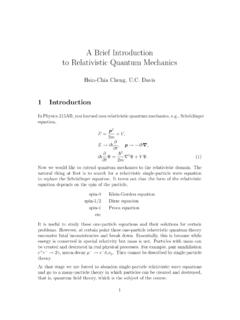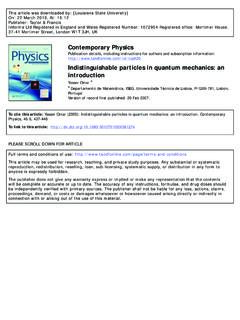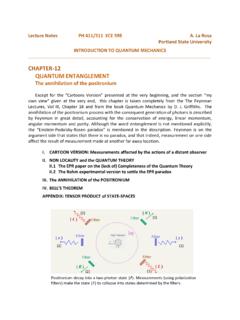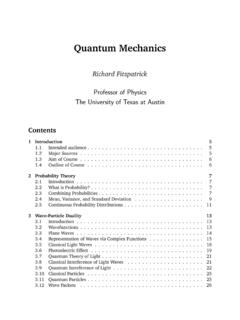Transcription of Introduction to Quantum Mechanics - Stony Brook …
1 Introduction to Quantum MechanicsThe Manchester Physics SeriesGeneral EditorsD. J. SANDIFORD: F. MANDL: A. C. PHILLIPSD epartment of Physics and Astronomy,University of ManchesterProperties of Matter:B. H. Flowers and E. MendozaStatistical Physics:F. MandlSecond EditionElectromagnetism:I. S. Grant and W. R. PhillipsSecond EditionStatistics:R. J. BarlowSolid State Physics:J. R. Hook and H. E. HallSecond EditionQuantum Mechanics :F. MandlParticle Physics:B. R. Martin and G. ShawSecond EditionThe Physics of Stars:A. C. PhillipsSecond EditionComputing for Scientists:R. J. Barlow and A. R. BarnettNuclear Physics:J. S. LilleyIntroduction to Quantum Mechanics :A.
2 C. PhillipsINTRODUCTION TOQUANTUM MECHANICSA. C. PhillipsDepartment of Physics and AstronomyUniversity of ManchesterCopyright#2003 by John Wiley & Sons Ltd,The Atrium, Southern Gate, Chichester,West Sussex, PO19 8SQ, EnglandNational 01243 779777 International ( 44) 1243 779777e-mail (for orders and customer service enquiries): our Home Page on rights reserved. No part of this publication may be reproduced, storedin a retrieval system, or transmitted, in any form or by any means, electronic,mechanical, photocopying, recording, scanning or otherwise, except under the termsof the Copyright, Designs and Patents Act 1988 or under the terms of a licence issuedby the Copyright Licensing Agency, 90 Tottenham Court Road, London, UK W1P 9HE,without the permission in writing of the Wiley Editorial OfficesJohn Wiley & Sons, Inc.
3 , 605 Third Avenue,New York, NY 10158-0012, USAW iley-VCH Verlag GmbH, Pappelallee 3,D-69469 Weinheim, GermanyJohn Wiley & Sons (Australia) Ltd, 33 Park Road, Milton,Queensland 4064, AustraliaJohn Wiley & Sons (Asia) Pte Ltd, 2 Clementi Loop #02-01,Jin Xing Distripark, Singapore 0512 John Wiley & Sons (Canada) Ltd, 22 Worcester Road,Rexdale, Ontario M9W 1L1, CanadaLibrary of Congress Cataloging-in-Publication DataBritish Library Cataloguing in Publication DataA catalogue record for this book is available from the British LibraryISBN 0-470-85323-9 (Hardback)0-470-85324-7 (Paperback)Typeset by Kolam Information Services Pvt.
4 Ltd., Pondicherry, IndiaPrinted and bound in Great Britain by Antony Rowe Ltd, Chippenham, WiltshireThis book is printed on acid-free paper responsibly manufactured from sustainableforestry, in which at least two trees are planted for each one used for paper my sons:JosephMichaelPatrickPeterThis page intentionally left blank ContentsForewordxiEditor's preface to the Manchester Physics SeriesxiiiAuthor's prefacexv1 PLANCK'S CONSTANT IN De Broglie Measurement10 The uncertainty principle11 Measurement and wave particle duality13 Measurement and non-locality16 Problems1172 THE SCHRO DINGER Waves21 Sinusoidal waves21 Linear superpositions of sinusoidal waves22 Dispersive and non-dispersive Particle Wave Equations26A wave equation for a free particle27 Wave equation for a particle in a potential energy field29 Problems2313 POSITION AND Probability35 Discrete
5 Random variables35 Continuous random Position Probabilities38 Two-slit interference38 The Born interpretation of the wave Momentum A Particle in a Box Expectation Quantum States50 Problems3524 ENERGY AND The Hamiltonian Normal Modes of a States of Certain A Particle in a Box II66A one-dimensional box66A three-dimensional States of Uncertain Energy71 Basis functions71 Energy probability Time Dependence74 Problems4775 SQUARE WELLS AND Bound and Unbound States83 Bound states85 Unbound states88 General Barrier Penetration94 Stationary state analysis of reflection and transmission95 Tunnelling through wide barriers97 Tunnelling electrons99 Tunnelling protons100 Problems51036 THE HARMONIC The Classical The Quantum Quantum States112 Stationary states112 Non-stationary Diatomic Three-dimensional The Oscillator Eigenvalue Problem123 The ground state125viiiContentsExcited states126 IsE0really the lowest energy?
6 127 Mathematical properties of the oscillator eigenfunctions128 Problems61287 OBSERVABLES AND Essential Position and Momentum138 Eigenfunctions for position138 Eigenfunctions for momentum139 Delta function Compatible Commutators142A particle in one dimension143A particle in three Constants of Motion146 Problems71488 ANGULAR Angular Momentum Magnetic Moments158 Classical magnets158 Quantum magnets159 Magnetic energies and the Stern Gerlach Orbital Angular Momentum163 Classical orbital angular momentum163 Quantum orbital angular momentum164 Angular shape of wave functions164 Spherical harmonics169 Linear superposition171 Problems81749 THE HYDROGEN Central Potentials179 Classical Mechanics of a particle in a central potential179 Quantum Mechanics of a particle in a central Quantum Mechanics of the Hydrogen Atom185 Energy levels and Sizes and Radiative The Reduced Mass Relativistic The Coulomb Eigenvalue Problem202 ContentsixProblems920510 IDENTICAL Exchange Physical Exchange Symmetry with Bosons and Fermions222 Problems1022411 Atomic Quantum States229 The central field approximation230 Corrections to the central field The Periodic What If ?
7 241 Problems11246 Hints to selected problems249 Further reading262 Index263 Physical constants and conversion factorsInside Back CoverxContentsForewordSadly, Tony Phillips, a good friend and colleague for more than thirty years,died on 27th November 2002. Over the years, we discussed most topics underthe sun. The originality and clarity of his thoughts and the ethical basis of hisjudgements always made this a refreshing exercise. When discussing physics, Quantum Mechanics was a recurring theme which gained prominence after hisdecision to write this book. He completed the manuscript three months beforehis death and asked me to take care of the proofreading and the Index.
8 Alabour of love. I knew what Tony wanted and what he did not want. Exceptfor corrections, no changes have been was an outstanding teacher who could talk with students of all had a deep knowledge of physics and was able to explain subtle ideas in asimple and delightful style. Who else would refer to the end-point of nuclearfusion in the sun as sunshine? Students appreciated him for these qualities, hisstraightforwardness and his genuine concern for them. This book is a fittingmemorial to page intentionally left blank Editors' preface to theManchester Physics SeriesThe Manchester Physics Series is a series of textbooks at first degree level.
9 Itgrew out of our experience at the Department of Physics and Astronomy atManchester University, widely shared elsewhere, that many textbooks containmuch more material than can be accommodated in a typical undergraduatecourse; and that this material is only rarely so arranged as to allow thedefinition of a short self-contained course. In planning these books we havehad two objectives. One was to produce short books: so that lecturers shouldfind them attractive for undergraduate courses; so that students should not befrightened off by their encyclopaedic size or price. To achieve this, we have beenvery selective in the choice of topics, with the emphasis on the basic physicstogether with some instructive, stimulating and useful applications.
10 Our secondobjective was to produce books which allow courses of different lengths anddifficulty to be selected with emphasis on different applications. To achievesuch flexibility we have encouraged authors to use flow diagrams showing thelogical connections between different chapters and to put some topics in starredsections. These cover more advanced and alternative material which is notrequired for the understanding of latter parts of each these books were conceived as a series, each of them is self-contained and can be used independently of the others. Several of them aresuitable for wider use in other sciences. Each Author's Preface gives detailsabout the level, prerequisites, etc.


![2 Introduction to Quantum Mechanics [8 lectures]](/cache/preview/e/6/f/8/e/2/9/8/thumb-e6f8e298944e077bc520facb1f806e08.jpg)







